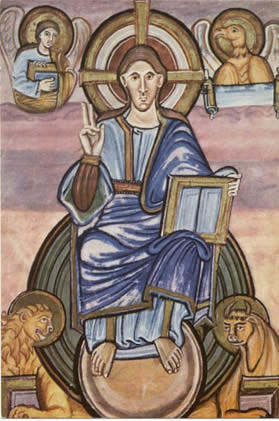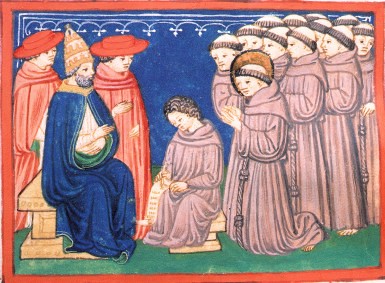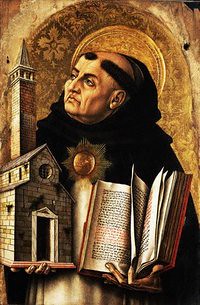 During the Middle Ages the Roman Catholic Church was the largest and single unifying structure in all medieval Europe. Regardless of social class or rank in medieval society, everybody's lives were in one way or another touched by the Church. During this period in history everyone in Europe was Christian, with the exception of only a small number of Jews.
During the Middle Ages the Roman Catholic Church was the largest and single unifying structure in all medieval Europe. Regardless of social class or rank in medieval society, everybody's lives were in one way or another touched by the Church. During this period in history everyone in Europe was Christian, with the exception of only a small number of Jews.Christianity was so important to medieval Europeans that a child would enter a life of service to God from the moment of its baptism, which during this period in history was done a few days after birth. As a child became older, the child would be taught basic prayers and would attend church every week and would learn of their responsibilities to the Church. The Church's laws applied to everyone, and each person in society was required to live by these laws and to pay heavy taxes to support the Church. In return for following the way of the Church, they were shown the way to everlasting life and happiness.
The Church, in addition to collecting taxes from people, would also accept gifts of all kinds from any individual who wished for special favors or wanted to be certain of their place in heaven.
 These gifts would include such things as crops, animals, land and sometimes even serfs. This tax collection and receiving of gifts allowed the Church to become very affluent and powerful, this power could then often be used to influence kings and queens to do as the Church wanted.
These gifts would include such things as crops, animals, land and sometimes even serfs. This tax collection and receiving of gifts allowed the Church to become very affluent and powerful, this power could then often be used to influence kings and queens to do as the Church wanted.The head of the Roman Catholic Church was God's representative on Earth, the Pope.
 Due to this position, the Pope had a great amount of power that could be used to influence kings and their advisors. If someone spoke out or acted against the Church, the Pope had the power to excommunicate them. To be excommunicated would mean that the person could no longer receive the sacraments and no longer attend any church or church services. As a result when they died they would go straight to hell and not be welcomed into heaven.
Due to this position, the Pope had a great amount of power that could be used to influence kings and their advisors. If someone spoke out or acted against the Church, the Pope had the power to excommunicate them. To be excommunicated would mean that the person could no longer receive the sacraments and no longer attend any church or church services. As a result when they died they would go straight to hell and not be welcomed into heaven.Along with the Pope, the Church was made up of many different people who were responsible for many different duties.
 After the Pope were the Cardinals, then the Archbishops followed by the Bishops who often acted as advisors to the kings and queens. Below these were the Abbots and Abbesses who were in charge of the monasteries and convents. Those who lived in monasteries and convents were known as Monks and Nuns respectively.
After the Pope were the Cardinals, then the Archbishops followed by the Bishops who often acted as advisors to the kings and queens. Below these were the Abbots and Abbesses who were in charge of the monasteries and convents. Those who lived in monasteries and convents were known as Monks and Nuns respectively.Exercises:
On a new page in your books put the Heading “Religion in the Middle Ages”. Under the heading write a 1/4 - 1/2 page summary based upon the information available from this link and this link. After you have completed the summary, find the definition of the following terms: Cardinal, Bishop, Friar, Priest, Monk, Nun, Abbott, Prior, Abbess, Abbey, Monastery, Tonsure. Then write the following sub-heading and the questions in your books and answer them in full sentences using the links to the websites listed below.
Monks and Nuns
1. What kind of work did Monks and Nuns do?
2. What services did monasteries offer?
3. Explain what would happen whilst Monks would eat
4. Pretend you are a Monk or a Nun. Write a letter home to your family explaining what your daily life is like. This should be at least 1/2 page




 11:50 PM
11:50 PM
 Mark
Mark



0 comments:
Post a Comment